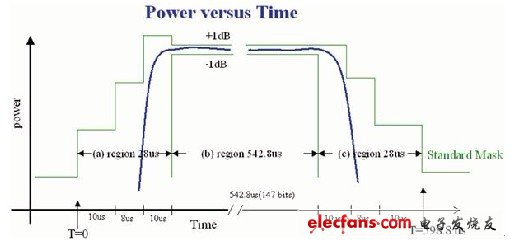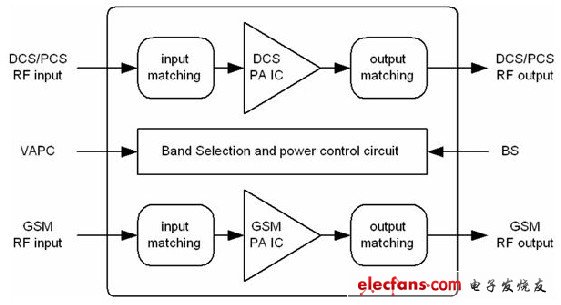What is a power amplifier?
Power amplifier (PowerAmplifier, referred to as PA) is referred to as power amplifier, commonly known as "amplifier", is the most basic equipment in the audio system, its task is to carry out the weak electrical signal from the signal source (professional audio system is from the mixer) Amplify to drive the speaker to make sound.
Characteristic requirements of mobile phone power amplifier
The GSM / GPRS quad-band mobile phone transmits signals according to the ETSI / 3GPP communication standard, so the characteristics of the power amplifier must meet the following requirements.
Generally speaking, the output power level of the PA is in the GSM850MHz / 900MHz band, which is divided into fifteen power levels such as 5 (33dBm) ~ 19 (5dBm). In the DCS1800MHz / PCS1900MHz band, there are 0 (30dBm) ~ 15 (0dBm) Waiting for sixteen power levels, with the distance of the mobile phone from the neighboring base station and the receiving status of the mobile phone, the output power level of the PA must be relatively adjusted and accurately set according to the instructions of the base station, not just a single output power.
Because the GSM / GPRS communication system is a TDMA system (TIme-Division-mulTIple-Access), signal transmission (up-Link) and reception (down-Link) do not occur at the same time, and PA is mainly responsible for transmitting mobile phone signals To the base station, the PA power operation response time must meet the specifications of the ETSI / 3GPP communication standard. As shown in Figure 1, it is divided into three time zones (a) 28us (b) 542.8us (c) 28us, in the (a) area, When the mobile phone wants to transmit the signal to the base station, the PA must prepare for power-ramping-up within 28us to keep the PA output power at a stable and fixed value in order to start the real mobile phone signal transmission work, which is (b) area, and when the signal transmission is completed, you must complete Power-ramping-down in (c) area 28us to turn off PA Power to save battery current consumption and enter the receiving mode (receive base station signal), in addition There are two points worth mentioning:
(1) In the areas (a) and (c), the reaction speed of the PA should be fast enough so that the PA can reach the PA full power output and no power output within 28us, and the increase rate of its power output (ramping- The up or ramping-down rate must also have an appropriate speed to achieve a very smooth power rise and fall curve, otherwise it is easy to produce so-called switching spectrum noise, which will affect the call quality of nearby mobile phone users.
(2) In the area (b), the output power of the PA must be very stable, and the power variation range is within ± 1dB, otherwise the signal that the mobile phone wants to transmit is easily modulated by the PA due to the unstable power of the PA itself, so Modulated spectrum noise is generated, which will greatly improve the BER (Bit-error-rate) of the mobile phone itself during the call, and make the call quality poor.

Figure 1 PA output power vs time chart
Because the longest distance between the mobile phone and the base station is about 35 kilometers, the output power of the PA is about 30 ~ 35dBm, so the PA needs a larger supply current, and its current can be as high as 1.6 ~ 2A. The output efficiency of the general PA is about 50% , Plus PA duty cycle (duty
cycle) to GPRS Class 12 application will reach 50%
(4 time slots), so the PA module will generate a lot of heat in the IC itself, so it must have a good heat dissipation treatment, otherwise the PA is easily damaged due to overheating.
The mobile phone itself is often used in a very bad environment, such as high-speed driving, harsh weather, etc., so the reception sensitivity (SensiTIvity) of the mobile phone itself is very high. At the same time, the output power required by the PA must be compared. High, so the requirements for the noise power of the receiving band that are relatively generated during PA operation will be more stringent.
Generally, in the normal operation mode of the mobile phone PA, the impedance seen by the output terminal is a 50Ω load, but when the mobile phone user uses the mobile phone improperly, such as holding the antenna or even unplugging the antenna, the PA load impedance will completely deviate from the normal operation. 50Ω load, this is the so-called PA mismatch (mismatch), under such conditions, PA power can not be sent out, will cause more heat to dissipate on the IC, easy to cause PA burnout, in addition, because the PA itself is large In addition to the output power, the power components will also generate a lot of thermal noise. The PA itself will have a great stability problem. If the mismatch occurs again, it will cause the PA to oscillate more easily, thus generating noise at other frequencies (SpuriousOscillaTIon noise) It affects users of other mobile phone systems, so the PA design itself must ensure that the PA will not oscillate or burn out under the condition of mismatch.
As mentioned in the previous point, PA is a high-power component, and its output power is impedance matching using microstrip transmission lines, so RF signals are easily radiated to PA peripheral mobile phone communication circuits through medium coupling and air, and even affect Proximity to mobile phone users. The most typical example is that the signal is coupled to the VCO in the PLL, which easily causes the frequency offset of the VCO. This will greatly affect the call quality of the mobile phone itself. Therefore, the screen defects and isolation of the PA design itself are a challenging topic.
The technology and operation of PA The design of PA in recent years due to the poor Q value of the IC output impedance matching circuit, so the structure of multi-chip module (MCU, Multi-Chip-Module) is mostly used, as shown in Figure 2.

Figure 2 PA functional block diagram
Rear Rack Battery,Lithium Battery Pack,Electric Bicycle Battery 48V,Electric Icycle Lithium Batteries
Changxing Deli Technology Co., Ltd. , https://www.delipowers.com